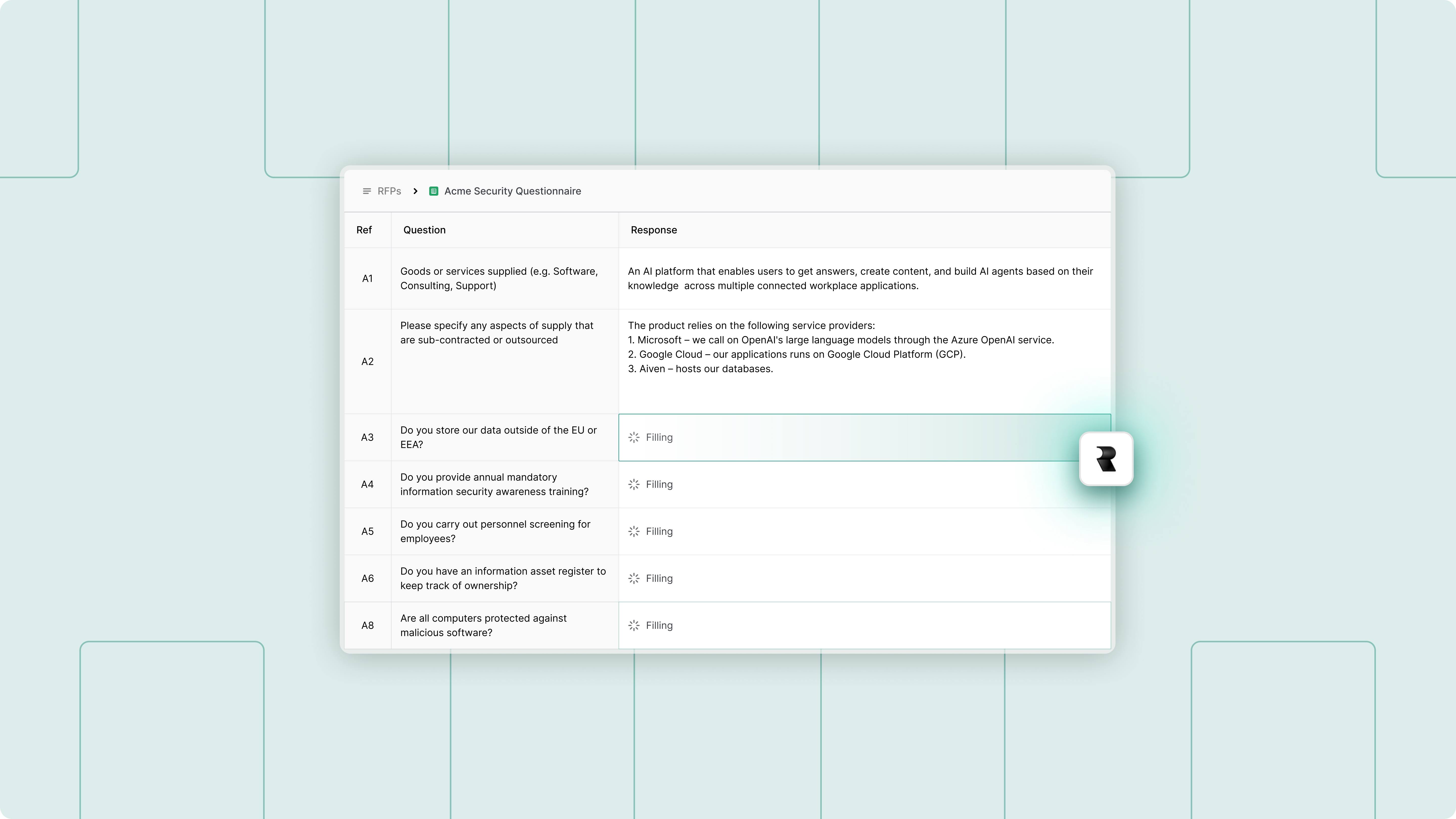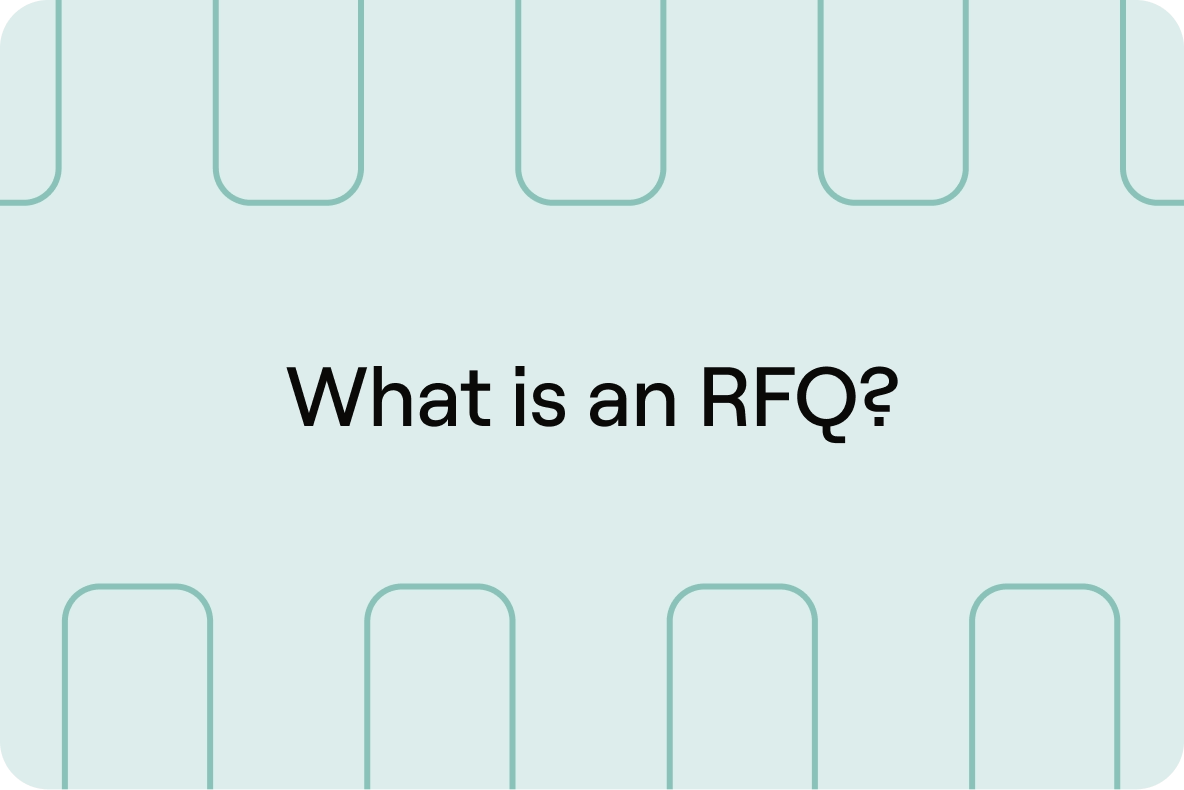Most sales teams treat the RFQ like a formality. After all, by the time it arrives, the hard work is done. You've won the evaluation, beaten the competition, and secured champion buy-in. The buyer just needs your final price to cut the Purchase Order.
Then the deal stalls for three weeks because Finance found a pricing error in row 47 of your spreadsheet. Or worse: the buyer quietly reopens the procurement to your competitor because your response took six days instead of two.
The RFQ is not a formality. It's the final, transactional hurdle where deals that were "99% closed" collapse because of slow responses, outdated pricing, or a single misaligned legal clause. Revenue leaders who treat the RFQ as an administrative afterthought are systematically leaking pipeline at the finish line.
The strategic trap is treating the RFQ like a continuation of the sales pitch. It's not. The time for selling value is over. This is a procurement compliance exercise focused purely on price and terms.
This guide defines the RFQ meaning, explains its critical strategic role in the final stage of procurement, and provides an actionable playbook for revenue teams to respond with the speed and accuracy required to close the deal. We'll show you exactly what is an RFQ and how to use automation to master this final, high-stakes transaction.
Definition: What is an RFQ?
The RFQ meaning is straightforward: Request for Quotation (or Request for Quote). It is a formal business document used by a buying organization to solicit competitive pricing and terms from potential suppliers for specific, well-defined goods or services.
The RFQ acronym (RFQ stands for Request for Quotation) is often confused with its cousins, the RFI and RFP, but its definition hinges on one word: Quotation.
When a buyer issues an RFQ, they are essentially saying: "We know exactly what we want, and we are ready to buy. We just need your best price and delivery schedule."
- High Buyer Knowledge: The buyer has already defined the requirements, often down to the SKU number, quantity, and technical specifications.
- Focus on Price: The primary evaluation criterion is cost, followed by payment terms and delivery logistics.
- Transactional Nature: The document is typically tabular (a spreadsheet or pricing schedule) and contains few, if any, open-ended questions.
- Binding Intent: Unlike an RFI, an RFQ response is often considered a binding offer for a specific period, making accuracy non-negotiable.
If you are asked what does RFQ mean, remember this: it means the buyer is in the final, transactional stage of procurement.
RFX decision matrix: RFQ, RFP, and RFI compared

The umbrella term for RFQs, RFPs, and RFIs is RFx (Request for X). The key to winning is understanding which stage of the buyer journey each document represents.
Here's what each stage means in practice:
RFI: The buyer is exploring
They don't have detailed requirements yet. They're asking, "What solutions exist? What should we even be looking for?" Your response should educate them, demonstrate expertise, and position your unique capabilities. Don't overshare proprietary details or pricing. The goal is to make the shortlist and influence the RFP criteria.
RFP: The buyer is evaluating
They know what they need (or think they do). They've defined requirements, timelines, and evaluation criteria. They're asking, "How will you specifically solve our problem?" Your response should be detailed, customized, and competitive. This is where you invest the 40-80 hours: detailed solution design, pricing, implementation plans, and proof points. The goal is to win the deal.
RFQ: The buyer is negotiating
They've already decided on the vendor and solution. Now they want your best price. This is a transactional document, often used in commodity purchases or when the buyer has already chosen you but needs competitive quotes for procurement compliance. Your response should be a clean, itemized price list. The goal is to close at your target margin without leaving money on the table.
For a deeper dive into these differences and when to use each document type, check out our comprehensive guide: RFI vs. RFP vs. RFQ: Key Differences Explained.
4 tips for winning the RFQ

When the request for quotation lands, your response strategy must shift from "selling" to "executing."
1. Transactional focus
The buyer is not looking for your company history, mission statement, or a recap of your product features. They are looking for numbers and terms.
- Do: Provide a clean, itemized price list and confirm compliance with technical specs.
- Don't: Include unnecessary case studies, marketing brochures, or lengthy value justifications. This wastes the buyer's time and signals you don't understand the RFQ process.
2. Accuracy is non-negotiable
An error in an RFQ response (a wrong SKU, an outdated price, or a misstated payment term) can be catastrophic. It forces the buyer to pause the process, request clarification, and potentially re-open the bid to competitors.
Action: Every data point must be pulled from a single, verified source of truth (e.g., your ERP, CRM, or approved knowledge base).
3. Internal alignment
The RFQ is where the rubber meets the road for internal stakeholders. Before you submit, ensure:
- Sales/RevOps: The quoted price matches the final negotiated price in the CRM.
- Finance: The payment terms (e.g., Net 30) are approved and align with company policy.
- Legal: Any required contractual clauses or indemnification terms are pre-approved.
4. Speed is leverage
In the RFQ stage, speed is a competitive advantage. A rapid, accurate response signals professionalism and commitment. More importantly, it reduces the window of opportunity for a competitor to submit a last-minute, lower-priced counter-offer to procurement. If you can turn around a complex RFQ in hours instead of days, you accelerate the deal velocity and get the Purchase Order signed faster.
RFQ responses: Format and key components
The typical RFQ format is highly structured, often delivered as an Excel spreadsheet or a structured document template. Your response must match this structure exactly.
A strong RFQ response will contain the following key components:
- Itemized Price List: The core of the document. This must clearly list the SKU/Service, Quantity, Unit Price, and Total Price.
- Payment Terms: Clearly state the accepted payment schedule (e.g., Net 30, Net 60).
- Delivery/Implementation Schedule: Specific dates or timelines for delivery of goods or commencement of services.
- Quote Validity Period: A clear expiration date for the quoted price (e.g., "This quotation is valid for 30 days"). This protects your margin.
- Compliance Checklist: A simple Yes/No confirmation that your product or service meets all the buyer's technical specifications.
Actionable Tip: Do not manually copy-paste data into these sections. Use standardized, pre-approved templates and AI-powered automation tools like Realm to populate the data directly from your verified sources.
Automate RFQ responses with AI

Realm is designed to streamline your entire response process, including RFQs, RFPs, RFIs, and security questionnaires such as VSQs, CAIQs, SIGs, DDQs. By connecting directly to your company's existing knowledge base, Realm's AI agents can automate up to 80% of your response drafting, allowing your team to focus on review and strategic customization.
7 steps for RFQ automation using Realm
Realm provides a centralized platform for managing the entire bidding process, from initial upload to final submission.
1. Upload the questionnaire
Start by uploading the unfilled RFQ file directly to the Realm platform. Realm supports diverse file formats, including Excel, PDF, and Word.
2. Analysis and parsing
Realm automatically analyzes the document, recognizing which questions, columns, or tables require a response. The system breaks the RFQ down into manageable sections for processing.
3. Choose your AI Agent
You can set up specialized AI Agents for different question types, product verticals, or customer segments. Each Agent can be grounded in a specific subset of your knowledge base to ensure the most relevant information is used.
4. Automate drafting
Realm drafts comprehensive, accurate, and compelling responses in your company’s language and tone of voice. Every answer is grounded in your company’s verified knowledge base, including past winning proposals. To ensure accuracy and easy verification, Realm cites the sources it references for every generated answer. This process prevents AI "hallucinations" by only using your approved, factual content.
5. Review and collaborate
AI drafts are complete in minutes, you can seamlessly review and finalize the responses with your team. You can manually edit the answer, approve it if it's final, or write a follow-up prompt asking the AI for edits or additions. You can also assign specific questions or sections to subject-matter experts (SMEs) for finalization.
6. Export and submit
Once all answers have been reviewed and approved, you can export the finalized document. The exported file will maintain the exact structure and formatting of the original RFI spreadsheet or document.
7. Repurpose winning responses
After the RFQ is completed and approved, the finalized responses are automatically added back into your knowledge base. This ensures that future AI Agents will automatically draw on your latest winning answers, continually improving response quality and consistency.
Final thoughts on RFQs
The request for quotation is the final, non-negotiable step in the procurement process. It is a test of your operational efficiency, not your salesmanship.
For revenue leaders, mastering the RFX spectrum (knowing when to educate with an RFI, when to propose with an RFP, and when to transact with an RFQ) is the key to predictable revenue growth.
The vendors who win consistently are those who can execute the final transaction flawlessly. They leverage AI automation to handle the volume and complexity of data retrieval with speed and accuracy, ensuring that a deal won on value doesn't die on a pricing spreadsheet.
If your team is still manually copying pricing data and legal terms into RFQs, you are creating unnecessary friction at the most critical stage of the sales cycle. Master the transaction, accelerate your deal velocity, and get the Purchase Order signed faster.
FAQ on RFQs
What does RFQ stand for?
RFQ stands for Request for Quotation. It is a formal document used in procurement to solicit price quotes and terms for specific, well-defined goods or services. The focus is on price and delivery, not on proposing a solution.
Is an RFQ legally binding?
An RFQ itself is generally not a contract. However, the vendor's submitted quotation is typically considered a binding offer for a specified period (the "Quote Validity Period"). If the buyer accepts the quote and issues a Purchase Order (PO) based on those terms, a contract is formed.
What is the difference between RFQ and Purchase Order (PO)?
The RFQ is the request for a price quote. The Purchase Order (PO) is the acceptance of that quote and the formal, legally binding document issued by the buyer to authorize the purchase of the goods or services at the agreed-upon price and terms.
When should a buyer use an RFQ instead of an RFP?
A buyer should use an RFQ when they have clearly defined requirements and the primary decision factor is price. They should use an RFP (Request for Proposal) when the requirements are complex, they need vendors to propose a customized solution, and the evaluation criteria include technical approach, methodology, and vendor expertise alongside cost.


